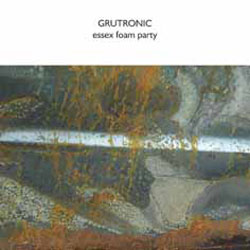
Grutronic is a collective of players who each have a history improvising in acoustic ensembles, on instruments like piano and drums, but who in present form rely on electronic sound production and processing. Each of the pieces here was recorded in real time, including in some cases, a concert setting. This fact makes the group's interactive skills and quick instincts all the more impressive, as does the fact that many of the tracks feature "special guests" Paul Obermeyer (sampler) and Orphy Robinson (vibes).
A stand out on the album, the title track unfolds dramatically, avoiding the "anything goes" logic that can quickly dampen the interest level in some electronic improv. One of the players maintains a staggered pulse in the lower register. Like William Parker's in Cecil Taylor's Feel Trio, this role functions as a sort of backbone � a center around which the other players subtly converge. The interactions evolve from there, and the music develops an intensity that seems to bring out creative choices in the musicians. This track is also one of the most sonically adventurous on the album. Despite featuring something of a tonal center, the tune plows through a thicket of different timbres and registers, with the players adapting and changing with notable rapidity.
The group also shines in effective use of repetition. Tonally complex loops, for example, help keep things interesting on "Concussion Vibes" and "Ball Pool Blues." These loops are not repeated hypnotically, but instead used as something like complex, temporally extended percussion sounds. So, instead of simple snare or tom sounds, for example, we hear more complex snippets of sound, strategically positioned in time as the overall mix evolves.
For a group whose core consists of improvisers using electronics and computers, though, the relative normalcy of the sounds explored on some of the tracks on the disc is something of a surprise. Take the sixth track, "Madness and Civilization," for example. While it begins with a rather insistent, jagged synth sound, much of the material for the remainder of the piece is played with what sounds like preset synthesizer patches (whether they are or not). The music itself has all of the earmarks of solid interactive improvisation, since it is surprising and runs along a tightrope at the edge of stochasticism. However, to hear this done with such relatively clean digital tones and, occasionally, the familiar bell-like tones of standard digital synths, is somehow curious. It perhaps harkens back to George Lewis' work with improvising software from the period of, say, Richard Teitelbaum's "Concerto Grosso 2," when some rather complex and challenging music was realized via the same synth sounds one could hear on pop radio. As on the present album, the music worked well, but somehow it seemed like there was this huge open frontier left unexplored.
Besides the beginning of "Madness..." there are more adventurous explorations of timbre to be found on Essex Foam Party. One of the most interesting pieces in that regard is the relatively brief "Foam sweet foam." The musicians work nearly as one, here, collectively deconstructing an aural atmosphere that initially sounds something like an atmospheric break in Lounge music. Things quickly get weird, though, as these seed materials are put through a processing wringer, and their referential connections are effectively stripped away, diced, warped, and otherwise completely retooled. The sounds don't quite reach the deviance level that would excite circuit benders and home-brew synthesists, but they come close.
Comments and Feedback:
|



